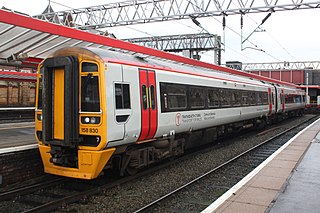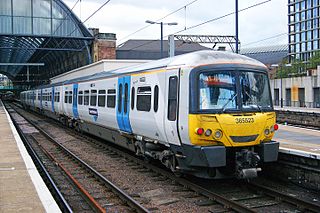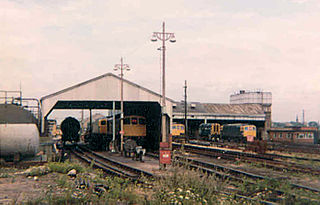
The British Rail Class 158Express Sprinter is a diesel multiple-unit passenger train, built for British Rail between 1989 and 1992 by British Rail Engineering Limited (BREL) at its Derby Litchurch Lane Works. They were built to replace many locomotive-hauled trains, and allowed cascading of existing Sprinter units to replace elderly 'heritage' DMUs. The Class 158's sister class, the Class 159 DMUs, are almost identical to the Class 158s; being converted from Class 158 to Class 159 in two batches to operate express services from London Waterloo to the West of England.

The British Rail Class 365 Networker Express were dual-voltage electric multiple-unit passenger trains built by ABB at Holgate Road Carriage Works in 1994 and 1995 to operate services in South East England and on the Great Northern Route. These were the last trains to be built at the Holgate Road works before its closure. Due to the refurbished front end resembling a smiling face, the trains were nicknamed "Happy Trains" by enthusiasts.

Newcraighall is a railway station on the Borders Railway, which runs between Edinburgh Waverley and Tweedbank. The station, situated 4 miles 54 chains (8 km) south-east of Edinburgh Waverley, serves the suburbs of Craigmillar and Newcraighall in the City of Edinburgh, Scotland. It is owned by Network Rail and managed by ScotRail.

Slateford railway station is a railway station serving Slateford in the city of Edinburgh, Scotland. It is located on the Shotts Line from Glasgow Central to Edinburgh Waverley via Shotts. The station has two platforms, connected by a stairway footbridge, and CCTV. It is managed by ScotRail.

Wrexham Central railway station is the smaller of two railway stations serving the central area of Wrexham in Wales, the other being Wrexham General. The platform can accommodate a three car diesel train, but has room for platform extension. It is the southern terminus of the Borderlands Line, also known as the Wrexham-Bidston line, which links north-east Wales to Merseyside.

Allerton TMD is a railway depot situated in Allerton, Liverpool. Situated opposite Liverpool South Parkway bus and rail interchange, it is visible from trains which are travelling between the former and Hunts Cross and the overhead passageway above platforms 1 to 4 at Liverpool South Parkway. The depot is located less than 2 km (1.2 mi) from the Freightliner intermodal terminal at Garston Docks and is also 7 km (4.3 mi) from the Stobart Rail intermodal depot in Widnes.

Laira T&RSMD is a railway traction and rolling stock maintenance depot situated in Plymouth, Devon, England. The depot is operated by Great Western Railway and is mainly concerned with the overhaul and daily servicing of their fleet of High Speed Trains and also the DMUs used on local services. The depot code "LA" is used to identify rolling stock based there.

Hither Green (London) Traction Maintenance Depot or Hither Green (London) TMD is a railway depot used for the maintenance and servicing of freight trains adjacent to the Hither Green marshalling yard. The depot is a hub for moving freight around southeast England. Hither Green TMD is owned and operated by DBS. The official depot code is HG. In steam days the shed code was 73C.

Shawfair is a railway station on the Borders Railway, which runs between Edinburgh Waverley and Tweedbank. The station, situated 5 miles 64 chains (9 km) south-east of Edinburgh Waverley, serves the villages of Danderhall and Shawfair in Midlothian, Scotland. It is owned by Network Rail and managed by ScotRail.

Eskbank is a railway station on the Borders Railway, which runs between Edinburgh Waverley and Tweedbank. The station, situated 8 miles 25 chains (13 km) south-east of Edinburgh Waverley, serves the towns of Bonnyrigg and Dalkeith in Midlothian, Scotland. It is owned by Network Rail and managed by ScotRail.

Newtongrange is a railway station on the Borders Railway, which runs between Edinburgh Waverley and Tweedbank. The station, situated 11 miles 77 chains (19 km) south-east of Edinburgh Waverley, serves the town of Newtongrange in Midlothian, Scotland. It is owned by Network Rail and managed by ScotRail.
The Edinburgh Glasgow Improvement Programme or EGIP was an initiative funded by Transport Scotland on behalf of the Scottish Government to increase capacity on the main railway line between Edinburgh and Glasgow, with new, longer electric trains running by 2017 and scheduled for full completion in 2019. It was expected to cost £742 million and delivered by Network Rail.

Abellio ScotRail, operating services under the name ScotRail, was the national train operating company of Scotland. A subsidiary of Abellio, it operated the ScotRail franchise from 1 April 2015, taking over from predecessor First ScotRail.

Craigentinny Traction Maintenance Depot is a railway depot in the Craigentinny area of Edinburgh, Scotland. The depot is operated by Hitachi Rail with a depot code of EC.

The Borders Railway connects the city of Edinburgh with Galashiels and Tweedbank in the Scottish Borders. The railway follows most of the alignment of the northern part of the Waverley Route, a former double-track line in southern Scotland and northern England that ran between Edinburgh and Carlisle. That line was controversially closed in 1969, as part of the Beeching cuts, leaving the Borders region without any access to the National Rail network. Following the closure, a campaign to revive the Waverley Route emerged. Discussion on reopening the northern part of the line came to a head during the early 2000s. Following deliberations in the Scottish Parliament, the Waverley Railway (Scotland) Act 2006 received Royal Assent in June 2006. The project was renamed the "Borders Railway" in August 2008, and building works began in November 2012. Passenger service on the line began on 6 September 2015, whilst an official opening by Queen Elizabeth II took place on 9 September.

Ayr TMD is a railway traction maintenance depot in Ayr, Scotland. The depot is located to the south of Newton-on-Ayr railway station. The depot code is AY.

Ilford EMU Depot is a traction maintenance depot located in Ilford, Greater London, England. The depot is situated on the Great Eastern Main Line and is on the north side of the line to the east of Ilford station, between that station and Seven Kings railway station.

Knottingley TMD was a traction maintenance depot located in Knottingley, West Yorkshire, England. The depot was situated on the Pontefract Line and was near Knottingley station. It opened in 1967 to maintain the locomotives and hopper wagons for a planned 75 Merry-go-round trains a day, expected to use the Wakefield and Goole line.

Healey Mills Marshalling Yard was a railway marshalling yard located in the village of Healey, south west of Ossett in West Yorkshire, England. The yard was opened in 1963 and replaced several smaller yards in the area. It was part of the British Transport Commission's Modernisation plan, and so was equipped with a hump to enable the efficient shunting and re-ordering of goods wagons. The yard lost its main reason for existence through the 1970s and 1980s when more trains on the British Rail system became block trains where their wagons required less, or more commonly, no shunting.

ScotRail Trains Limited, trading as ScotRail, is a Scottish train operating company that is publicly-owned by Scottish Rail Holdings on behalf of Transport Scotland and the Scottish Government.



















